What Is Air Pollution?
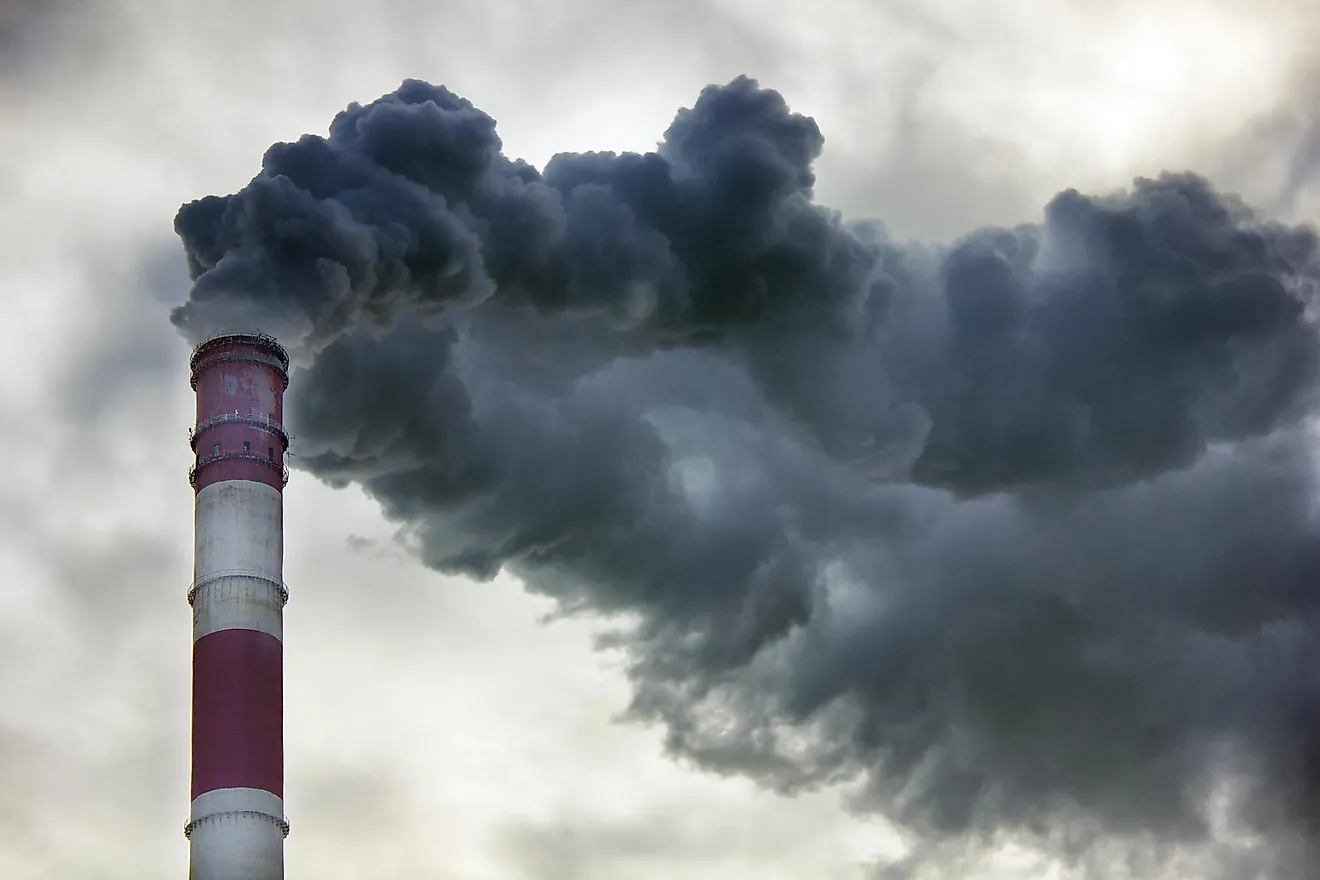
- Since toxins accumulate up the animal food chain, top predators are likely to be full of toxins and die from toxin-related malaises.
- Acid rain can lead to baldness, thin and dull hair, head skin irritation, and other scalp problems.
- About 7 million deaths incurred worldwide are directly related to the effects of indoor and outdoor air pollution each year.
Among other human-induced problems that the world faces today, including water scarcity and loss of biodiversity, air pollution is a great concern in nearly all the places on the Earth. Having begun spiralling down during the industrial revolution, many industries today are more potent than ever at producing major air pollutants.
Contents
- What Causes Air Pollution?
- What Are Primary And Secondary Air Pollutants?
- How Does Air Pollution Affect The Environment?
- How Does Air Pollution Affect Humans?
- What Is Indoor Air Pollution?
- How Many People Die From Air Pollution?
- How Is Air Pollution Measured?
- How To Reduce Or Stop Air Pollution?
What Causes Air Pollution?
Air pollution is the release of gases and small fragments of human-made particles and chemicals into the air, the concentration of which is harmful to all living and breathing creatures on this planet.
Upon studying global warming, researchers have determined that air pollution is a significant contributor to this problem. The opaqueness of air-polluting particles in the atmosphere traps the sun rays in and prevents the Earth from cooling off naturally. At the same time, other air pollutants are destroying the outer atmospheric layer, primarily the ozone layer (which prevents too much sunlight from entering). Major changes in weather patterns have been recorded around the world, from unexpected monsoons to expanding deserts, caused by primary and secondary air pollutants contributing to climate change.
What Are Primary And Secondary Air Pollutants?
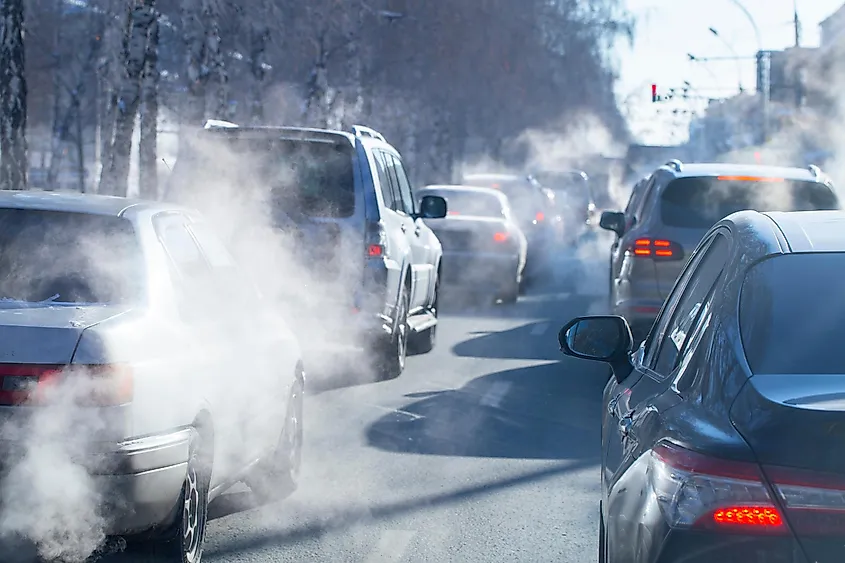
Primary air pollutants are small solids and particulates (liquid particles) that are suspended in the air and come at less than 10 micrometers in size. They can be observed in the form of soot, dust, smoke, fumes and mists, but some are invisible to the human eye. Primary air pollutants are released from the reaction of burning fossil fuels, like when a motorized vehicle running on gasoline emits carbon monoxide. Natural gas burned in houses for heating, most types of fires as well as power plants that release carbon dioxide, carbon monoxide, and sulphur dioxide, are also primary air pollutants. Diesel-run cars and some industrial processes release lead fumes, and at 0.5 micrometers in size, they are extremely harmful primary air pollutants.
Secondary pollutants occur when a primary pollutant reacts with another, often natural substance and creates a different pollutant. Ozone is considered a secondary air pollutant as it is formed when a primary air pollutant, nitrogen dioxide, reacts with the hydrocarbon particles naturally present in sunlight. It is the main component of smog, which is also a secondary pollutant.
How Does Air Pollution Affect The Environment?
Animal Health And Behavior
Since the exchange of gases does not happen in the same manner for all of the members of the animal kingdom, the negative effects of air pollution strike them in different ways, as well. Depending on whether they use lungs, gills, or passive diffusion across the surface of their skin for breathing, here are some of the most detrimental problems the animal kingdom faces from air pollution.
The inhabitants of the sky suffer from smog, with the warm dirty air remaining in their natural habitat. Top predators including eagles are especially susceptible to diseases from accumulated food toxicity.
One of the most common ways air pollution affects animals is through feeding. After gaseous fumes and small air particulates are absorbed by or descend on to primary food sources like grass, they are digested by herbivores and remain in the animal's body in the form of a toxic buildup. As that animal is eaten by a carnivore, such as an eagle, the toxins build up as they travel through the natural food chain.
Toxins, whether breathed in or digested, may disrupt the endocrine function of the animal, cause organ injury, weaken their immune system, alter their mental state, and make them more vulnerable to die from stress. Other common side effects are low reproductive success, weak newborns, and early death. Consequently, the premature deaths and the dwindling of species will leave predators to starve, creating an imbalance where a food source of the predator, no longer threatened, will deplete its food source or other natural resources it relies on.
Lastly, animals are very in-tune with climatic conditions, carefully choosing the environment they feel most comfortable in. On top of having to deal with floods, excessive sunlight, and relocation to less optimal environments, air pollution and climate change affect the natural patterns of the animal kingdom, including birds flying south for the winter and bears' hibernation schedules.
Ozone
Similar to how car exhaust causes breathing problems in humans, smog, lower atmosphere ozone, and other particulate matter affect the lungs and cardiovascular system in animals, as well.
A natural reaction in the upper atmosphere, nitrogen dioxide and hydrocarbon particles combine in the sunlight to form a protective layer, the ozone layer, preventing the sun's harmful rays from entering the troposphere (lower atmosphere) of the Earth. Ever since the nitrogen dioxide-producing motorized vehicle has been invented, this complex reaction now also occurs in the troposphere, and is known as photochemical smog. This is why sunny places like Los Angeles, with ample industry and countless highways, are major contributors to and suffer significantly from air pollution.
While plants photosynthesize oxygen and help clean the air, other environmental features, including mountains, certain weather conditions and temperature inversion (when cool air descends below the warm air), prevent the smog from clearing. Plants and their leaves are also damaged by the ozone, which impedes their ability to cleanse the air.
Marine Life
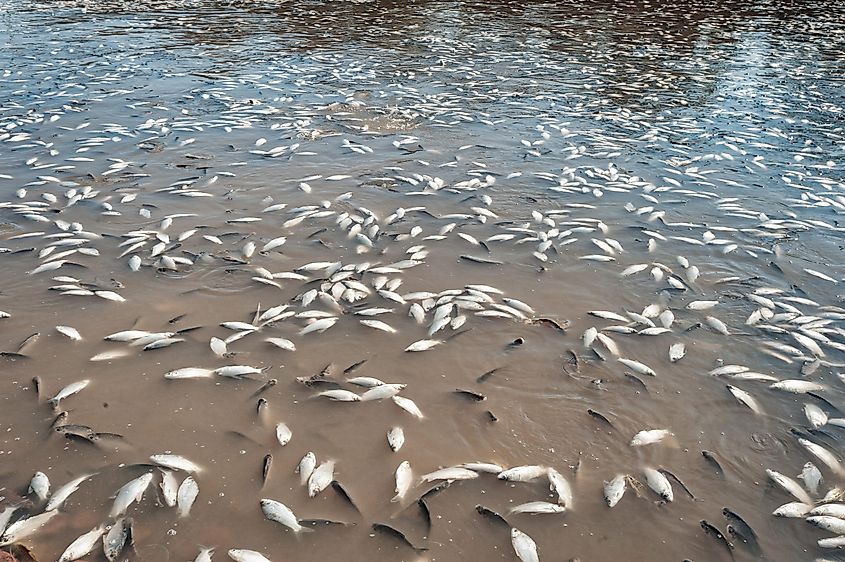
Acid rain occurs when the power plant-released sulphur dioxide combines with water vapour in the air to create sulphuric acid suspensions or mist in the air, which is brought down by the rain. Although harmful for scalp-health in humans, acid rain is deadly to smaller animals and plants in the waters, where it tends to stay and accumulate over time in high concentrations. Almost no part of the world is immune to this problem, including thousands of lakes and streams in and around large cities of Europe, parts of China, south-eastern Canada, and the north-eastern United States.
Mercury and lead are usually redistributed into the waters through water pollution, but small amounts of their evaporated fumes can also be brought down into the lakes and coastal waters during rainfall, making fishing in and around industrious areas particularly precarious.
How Does Air Pollution Affect Humans?
Lead
There is a good reason why lead thermometers are becoming less common, and many countries put a ban on lead-producing vehicles. Lead is especially harmful to children, whose bodies are not strong enough to handle even the smallest amounts of this potent toxic when inhaled in its fume or dust forms.
Depending on the amount and duration of exposure, effects can range from the immediate impediment of the brain's function, reflected in slowed thought process, awkward movements and sleepiness, to permanent learning disabilities, paralysis, seizures, and even death from lead poisoning. Nevertheless, the airborne lead particles are still released by some major industries, including oil refineries and smelting.
Carbon Monoxide
Carbon monoxide can be fatal if a person is left in a running vehicle in an unventilated area, such as a garage. A person experiencing carbon monoxide poisoning will feel overwhelming drowsiness as the pollutant displaces oxygen particles in their bloodstream. As asphyxiation, the extreme lack of oxygen in the body, occurs, the unconscious person stops breathing and dies soon after.
Sulphur Dioxide

Sulphur dioxide is most commonly released in power-generating plants that burn impure coal and oil that contain sulphur. This gas cannot be seen but is pungent in odour, and it will leave one with a teary-eyed effect at low concentrations, cause throat irritation if exposure continues, and can eventually lead to lung failure from scarring at high concentrations.
Sulphur dioxide also reacts with oxygen and water vapour in the air to form airborne suspensions of sulphuric acid. When it rains, raindrops bring along this acid in the form of acid rain, potentially causing baldness, hair dullness, and other scalp problems for those who have been exposed to it. That is why it is important to have a head covering in highly industrious cities during rainfall.
Lastly, sulphur dioxide steals from the economy by oxidizing the surfaces of structures to cause expensive damages in need of repair. Corrosion of rooftops and deterioration of building facades and monuments are its most known work.
Nitrogen Dioxide
Nitrogen dioxide, a form of nitrogen oxide, is released by coal-burning plants when the molecular nitrogen in the air reacts with oxygen at high temperatures of the combustion process. Nitrogen dioxide has many similar properties and effects to sulphur dioxide, in that it is also a pungent and irritating gas, which causes serious lung problems. Edema, a build-up of lung fluid, is a common aftereffect of inhaling nitrogen dioxide in its concentrated gaseous form.
Nitric acid, a component in acid rain, is created when nitrogen dioxide interacts with the atmosphere. It is also a contributing compound in smog formation.
Other Air Toxics
Other air toxics include arsenic, asbestos, benzene, beryllium compounds, cadmium compounds, chlorine, coke oven emissions, cyanide compounds, formaldehyde, lead compounds, mercury compounds, nickel compounds, radionuclides, including radon, radium and uranium, selenium compounds, and vinyl chloride. These potent air toxics have gruesome effects on the whole human system.
Affecting both brain tissue and fetal development, the hundreds of chemicals and compound variations released into the air may have immediate and postponed effects in humans, as well as short and long-term health consequences. Among other progressive pulmonary illnesses, air toxics may cause the development of asthma and tuberculosis. After years of studies, it is clear that prolonged exposure to chemicals mutates human cells (think of the Chernobyl accident), causing cancer.
Upon entering the lungs and blood, they induce a whole series of cardio-pulmonary malaises. As the body tries to rid itself of these harmful particles, their presence will quickly become evident in various skin conditions, digestive problems, and the ability to rid of waste.
Socio-Economic Effects
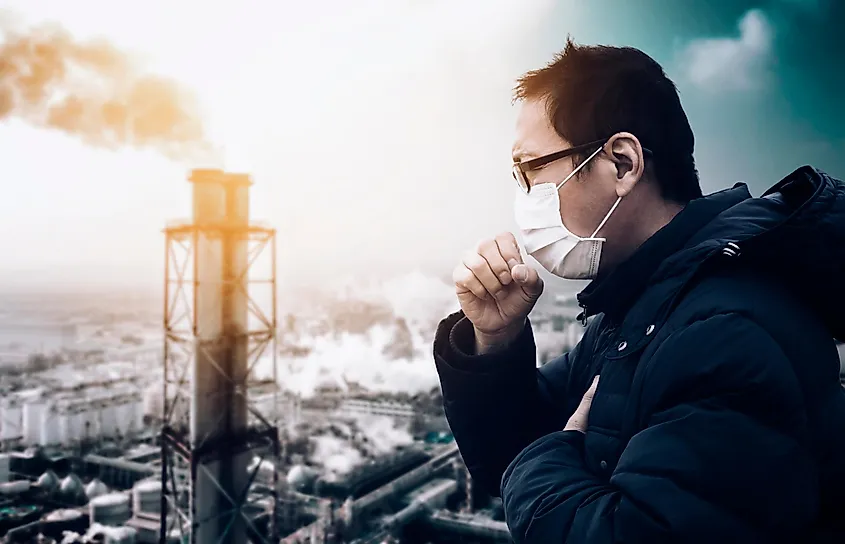
Air pollution and global warming also affect the societies and the economies of all countries in the world. The major strain faced by health systems dealing with malaises caused by air pollution, lower food production of unyielding crops, and shortages of water for whole populations are among the major socio-economic implications.
What Is Indoor Air Pollution?
The most common indoor air pollution comes from the chemicals used in households, such as cleaning products and disinfectants, room sprays, and even burning incense and scented candles. Using perfume or body spray at work, on the airplane, or other indoor spaces may cause irritation and breathing problems for others.
Today, more people make a conscious choice of switching to natural products for cleaning and body care. Although less harmful for the environment, even naturally sourced air pollutants will irritate the skin, nasal passages, and cause breathing problems for sensitive individuals.
How Many People Die From Air Pollution?
In 2018, the World Health Organization (WHO) has determined that nine out of ten people on the Earth breathe polluted air on daily basis. Globally, about 7 million deaths are incurred directly from the combined effects of indoor and outdoor air pollution each year. Of those, 2.2 million occur in the Western Pacific region, which stretches from China and Mongolia to New Zealand, covering over 28 countries.
How Is Air Pollution Measured?
Air pollution is measured to examine its quantity, compounds, and effects on the environment and human health, to compare this data periodically to notice trends over time. The measurements are taken in various ways depending on the source.
Carbon monoxide, ground ozone, lead, nitrogen dioxide, particular matter content, and sulphur dioxide are the most commonly measured air pollutants today. Performed by scientists and industry specialists, the measurements are reported to the appropriate governing bodies, which use the data to enforce controlling measures on their production. Measurements can also be simulated using computer models to predict the extent of the impact.
Some emissions can be measured directly from the source, such as car emissions from the tail pipe, using a gauge. The sample is taken for further examination of the compounds, with effects determined upon multiplying by the number of cars of the same make in the country.
Levels of radiation can be measured by Geiger counters, ionization chambers, and personal dosimeters. Atmospheric air pollution is measured in micrometers, while the concentration of a substance is measured as a mass or a volume per meter cubed. Lichen, a moss, can be used to measure the levels of air pollution in forests. A sun photometer can measure the amount of aerosol in the atmosphere.
How To Reduce Or Stop Air Pollution?
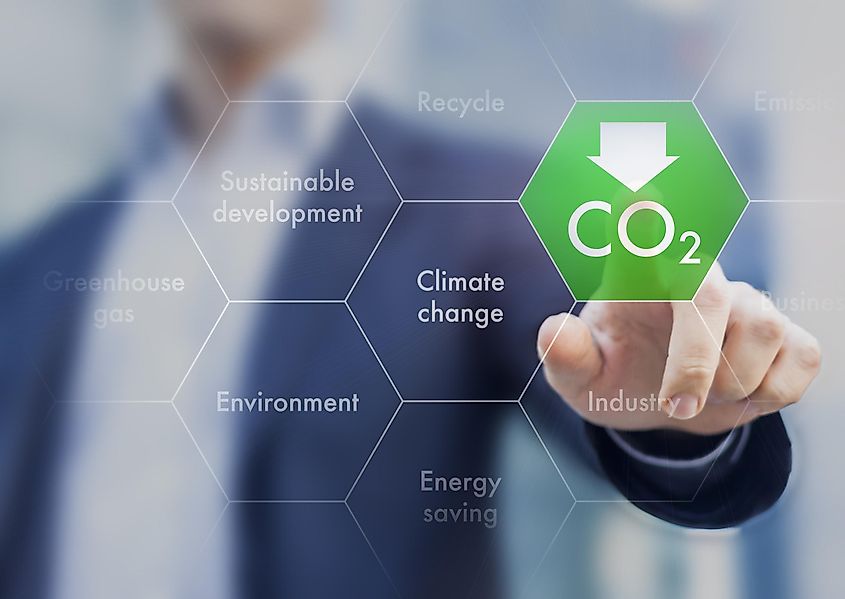
The future generation, whose parents dealt with air pollution, are more likely to be born weaker and with a predisposition to health concerns, not to mention having to deal with their own air pollution, should it keep increasing.
The first air toxics were regulated in the US by the 1970 Clean Air Act, including arsenic, asbestos, benzene, beryllium, coke, mercury, radionuclides, and vinyl chloride. In the US in 1990, 189 different substances were regulated, while by the end of that decade, control measures were enforced on specific sources that released more than 10 tons of these materials or more than 25 tons of their combinations per year.
In many countries, there is already a complete ban on the use of lead in gasoline, including in the US since 1996. Power plants were also redesigned to maximize their combustion efficiency which minimizes the release of carbon monoxide. Sulphur dioxide, released through the combustion of impure coal and oil, is minimized by sourcing those samples out.
Although the costs to make all this possible add up, it will be more expensive not to do anything, in terms of flailing human health and the deterioration of the environment. Even without deforestation, there are not nearly enough trees in this world to clean the air if pollution continues increasing rapidly.
On a personal level, there are a few options one can take to reduce their impact on outdoor air pollution, thus helping to fight climate change. Individuals can choose to prioritize public or green transit instead of car use, avoid burning leaves, trash or other materials, and prioritize electric lawn equipment over gas-powered.
While scientists and governments are working together to limit outdoor air pollution, there are multiple actions one can take to prevent its indoor companion. By avoiding room sprays and potent chemicals when buying cleaning products, as well as switching to naturally sourced ones, one will be helping the environment, as well as staying healthier within their own home. Being conscious about one's environment when using body care products, is also important, as some people may develop asthmatic symptoms from the most innocent of scents and other reactions from various chemicals expelled into the air.











